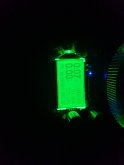Doing a bit of rough math.
Assuming the following
4 cell stack
Stress area of 1/4 rod is 0.031 in2. Steels elastic modulus is 29,000,000psi. Calculating for Krod is (0.031*29,000,000)/11.3 = 79,557lbs/in.
So 4 * 79,557 * 0.078 = 24,821lbs.
Of course this assumes that the cells MUST expand 0.5mm each during charging, which I have not verified, and I doubt they will if constrained with a "300kgf fixture".
But it does pose the question if its best to clamp cells at low SOC. I would personally just clamp when fully charged, which is typically the cell state after a top balance. Then verify cell security after a discharge.
Assuming the following
4 cell stack
- 0.5mm expansion per cell, so 2mm stack growth during charging from 30% SOC
- clamped with a rigid end plate (thick aluminum etc)
- 72mm nominal cell thickness for a total stack thickness of 11.3"
- clamped with 4 1/4" steel threaded rods
Stress area of 1/4 rod is 0.031 in2. Steels elastic modulus is 29,000,000psi. Calculating for Krod is (0.031*29,000,000)/11.3 = 79,557lbs/in.
So 4 * 79,557 * 0.078 = 24,821lbs.
Of course this assumes that the cells MUST expand 0.5mm each during charging, which I have not verified, and I doubt they will if constrained with a "300kgf fixture".
But it does pose the question if its best to clamp cells at low SOC. I would personally just clamp when fully charged, which is typically the cell state after a top balance. Then verify cell security after a discharge.





